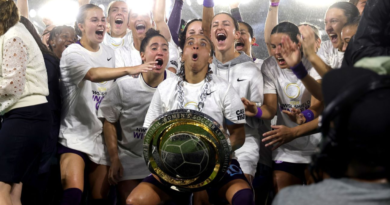The best and worst schedules in women's college basketball
Despite LSU winning the NCAA title last April as the lowest-seeded women’s college basketball champion since 1997, seeding matters. While not always the case — LSU was a No. 3 seed — a team’s seed often helps ensure more favorable matchups and geographical placement within the NCAA tournament bracket.
So how can teams maximize their seed? By playing a good schedule and succeeding against it. Nonconference schedules are the part coaches and athletic directors can control. All the debates in February and decisions in March about seeds often revert to what teams did with that control.
Bottom line: If teams schedule well, they generally get rewarded by the NCAA selection committee.
So, which teams’ slate of nonconference games will likely help them come March? And which teams will wish they had added a marquee game or two?
Schedules that should help

The top of this list is regular domain for the Huskies, who have had the NET ranking’s No. 1 nonconference schedule each of the last two years. That should be the case this season, too. Seven of UConn’s first 10 opponents appeared in the latest women’s Bracketology. The highlights: vs. UCLA in the Cayman Islands on the day after Thanksgiving, followed by a trip to Austin to play Texas nine days later, and games against North Carolina and Louisville later in December.
Within the first 10 days of the season, the Huskies visit NC State and host Maryland. Matchups with Notre Dame and South Carolina come later in the season. The only negative: no UConn-Tennessee. The latest incarnation of what was once the best rivalry in women’s sports ended after last season’s January meeting.

Not having the Huskies on the slate doesn’t hurt the Lady Vols’ schedule quality. They open at Florida State and then play Indiana and Oklahoma on a neutral site and host Notre Dame before November is over, with Ohio State and Middle Tennessee in the first week of December.
Despite its difficulty, this schedule should be more manageable than last year’s. Tennessee lost six games before Christmas in 2022 against the No. 2 rated nonconference schedule.

Notre Dame in Paris and Maryland six days later is a challenging start to the season for the Gamecocks. Another back-to-back three weeks later has South Carolina going to North Carolina and Duke. November will be a telling month for Dawn Staley as she tries to formulate a new rotation after losing five starters.
The Gamecocks aren’t done there. Utah and UConn come later in the season.

Along with teams like South Dakota State, Middle Tennessee and Belmont, Gonzaga year after year disproves the notion that teams from smaller leagues can’t get the power schools to play them. The Zags have done so again in 2023-24, with games against Washington State, Stanford, Louisville and Arizona. A win in any of those games will boost Gonzaga’s NCAA tournament seed.
The Bulldogs, a big favorite to win the West Coast Conference, have also thrown in two quality mid-major matchups, hosting the Jackrabbits and Toledo.

If the Irish can get even one win in games against three potential top-10 opponents (South Carolina, Tennessee and UConn), it will go a long way to establishing them as a possible No. 2 or 3 seed in the NCAA tournament. If Notre Dame goes 0-3 in those games, Illinois (Nov. 18) and Purdue (Dec. 17) offer solid competition that become must-wins for the Irish to stay among the top-16 teams in the country.
Schedules that might hurt

LSU Tigers
It ultimately didn’t matter that LSU had the 320th-ranked schedule strength according to the NET last season. A national championship is a national championship, regardless of the path. That doesn’t mean that schedule wasn’t criticized all season long. It was the chief reason the Tigers were only a No. 3 seed despite a 28-2 record.
This season’s schedule is better, but not by much. Having Colorado and Virginia Tech on the schedule in November helps immensely. LSU didn’t play anyone as good as either the Buffaloes or the Hokies in the first two months last year. However, everyone else on the Tigers’ nonconference schedule this season, with the exception of Virginia at a Thanksgiving event in the Cayman Islands, ranked outside of the NET top-100 in 202-23. More striking is that six of those teams were also lower than 300. This schedule could once again negatively impact LSU’s seed.

While LSU proved that having a weaker nonconference schedule as a member of the SEC might not be a big deal, the Rebels’ collection of November and December games won’t do much to help the NCAA tournament seed of what could be the best Ole Miss team since at least 2007. Six opponents who were 252 or below in the NET a year ago, plus 11-18 Temple make up more than half of the Rebels’ nonconference schedule.

Playing two fellow Final Four teams in Iowa and LSU in November is appealing. But Kansas is the only other opponent that is a likely candidate for an NCAA tournament at-large bid. The Hokies play five games against teams that averaged 288 in the NET a year ago: Houston Christian, UNC Greensboro, Long Island Sharks, Radford and William & Mary Tribe. That’s too many games in which Virginia Tech won’t be tested.

This isn’t to call Iowa’s schedule bad. There just isn’t any game that pops other than that meeting against Virginia Tech in Charlotte on Nov. 9. The rest of the nonconference slate fails to provide any showcase games for Caitlin Clark. Kansas State, which beat Iowa last season, is a good opponent but a borderline top-25 team. And that’s the Hawkeyes’ second-best game.
It hurts the Hawkeyes that Iowa State is expected to be down after significant personnel losses. And while Drake, Cleveland State, Bowling Green and a possible matchup with Florida Gulf Coast are a good group of mid-majors, they don’t move the NCAA tournament résumé needle.

After games at Baylor and against South Carolina on a neutral site, the strength of the Utes’ schedule falls off a cliff. They play two non-Division I games and another against a team — Merrimack — in its first year in Division I. Mississippi Valley State, South Carolina State and Weber State all finished last season 310 in the NET or worse.
The Pac-12 will be deep and competitive, but Utah won’t have much of a résumé before it gets to conference play.




